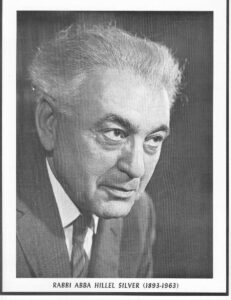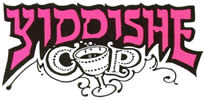WHO BY FIRE
Rabbi Abba Hillel Silver, pictured below, was the biggest Zionist to come out of Cleveland. If you know anything about American Jewish history, you know this guy. He and Rabbi Stephen Wise were the big Jews in the pre-WWII American rabbinate. Silver was the rabbi at The Temple –Tifereth Israel, a k a Silver’s Temple. He lobbied for the state of Israel back when many American Jews were not too sure that was a good idea.
My family belonged to Silver’s Temple. The temple’s official name was The Temple.
“Which temple do you belong to?”
“The.”
“The what?”
“The Temple. It’s The Temple.”

“The Temple” morphed into The Temple-Tifereth Israel after the rabbi and his son (also a rabbi) died. My family didn’t really fit in there in the 1960s, because many of the members were a lot richer, many from Shaker Heights. One Shaker kid arrived in a station wagon driven by a chauffeur with a shiny-visor cap.
Rabbi Silver was a chochem (wise man). He knew his stuff. And he hung with the guys from Telshe Yeshiva, too. The black-hat Orthos. He covered all the bases. What do I know? I was 13 when Rabbi Silver died.
My younger son went through religious high school at The Temple. The place had mellowed by then. It wasn’t as snobbish. Nobody cared anymore if you were Deutsche Yehudim — one of Cleveland’s original German Jewish settlers. When my parents left Silver’s, they went to Temple Emanu El, a middle-class temple in the ‘burbs. My mom taught macramé there and volunteered in the sisterhood gift shop. She collected “donor points” for volunteering — points that reduced her admission costs to the annual temple dance.
Yiddishe Cup has played some of these temple dances. Not so many lately because few people want to dance at temples. They’d rather stay home and watch people dance on TV. We played a “dance,” sort of, last Saturday night. Simchat Torah. That was very low key because of the war. The rabbi and I decided the band would play a few Israeli tunes and dances. Nothing too wild.
My parents joined the heymish synagogue, Emanu El, after I was confirmed. (Heymish — the word — should be banned, by the way. Too heymish.)
On the High Holidays, I went with my parents to Emanu El, or else with my friends to Hillel at Case Western Reserve. After Rosh Hashanah services, we’d eat at Tommy’s restaurant. I tried that again this year – the Tommy’s part. You couldn’t get into Tommy’s this year after Rosh; it was jammed with yidn.
Years ago an older woman told me, “I joined Fairmount Temple because I like the music there.” She had other reasons too: Brith Emeth didn’t have enough money to spend on carpet, she said, and she liked Fairmount Temple’s classic Reform music. That stuck with me: joining a temple for the music.
Nowadays Fairmount is contemporary guitar-centric Jewish music, and I like the cantor, Vlad Lapin. My band played there last Friday night. That was lively. That was pre-war. (And don’t worry, we’re going to kick out the jams the next time we play.)
I belong to Park Synagogue because, among other things, I like the music and the rabbi, who likes my band, which is scheduled to play Park Synagogue’s holiday celebrations until 5800. I once played a holiday gig at another shul, where the rabbi left early to attend a rock concert. He said he was seeing a famous band downtown. I wasn’t impressed. Hey, the rabbi was walking out on Yiddishe Cup! It’s impossible to be a rabbi.
Park Synagogue uses a choir once in a while. Some Jews think a choir is super-goyish. Not true. In Europe there were synagogue choirs as far back as the 1500s.
Some temples have rock bands. (I have subbed in several rockin’ shabbat bands.) Some congregants really enjoy that groove. My son the drummer got his start playing in a rockin’ shabbat band at The Temple. Rock on.
By the way, read Matti Friedman’s book about Leonard Cohen playing for the troops in the Sinai in 1973. Who By Fire.
I can see picking a shul for the music. Why not. I enjoy hearing my cantor, Misha Pisman, and I like the cantors my shul imports for the Rosh Hashanah overflow. Either way I’m OK — main sanctuary (with the regular cantor) or overflow with the sub.
I feel like playing music right now for the troops and the people of Israel. Am Yisrael Chai, for starters.

2 comments
I used to lead a Reconstructionist synagogue band in
Attleboro, Massachusetts. We played Klezmer and some
liturgical music. Now that I am black hat Orthodox without a black hat, no live music on Shabbos and Yom Tov.
But there is actually an incredible amount of Orthodox music out there.
Our two oldest synagogues were founded with permanent Hebrew names: Anshe Chesed (today Anshe Chesed Fairmount Temple) and Tifereth Israel (today The Temple – Tiferreth Israel), but they were known by their locations: Scovill Avenue Temple, Willson Avenue Temple. Around 1895 Tifereth Israel began calling itself “The Temple.”
The music of the 1930s and 40s, from the Union Hymnal, was truly Goyische, much of it from the Protestant Hymnal, the words scrubbed a little, with choir and organ and sung without feeling. Think of white bread.
Leave a Comment